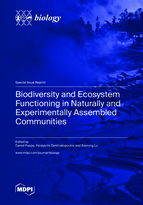Biodiversity and Ecosystem Functioning in Naturally and Experimentally Assembled Communities
A special issue of Biology (ISSN 2079-7737). This special issue belongs to the section "Conservation Biology and Biodiversity".
Deadline for manuscript submissions: closed (15 March 2023) | Viewed by 38235
Special Issue Editors
Interests: biogeochemical element cycling; protist biodiversity; agricultural plant–soil systems; sustainable agriculture; effects of silicon on plants; ecosystem functioning
Special Issues, Collections and Topics in MDPI journals
Interests: biodiversity and ecosystem processes; functional plant ecology; community ecology; biodiversity conservation; conservation policy
Special Issues, Collections and Topics in MDPI journals
Interests: biodiversity; conservation biology; evolutionary biology; population genetics; biotechnology; transgenic biosafety; agricultural botany
Special Issue Information
Dear Colleagues,
Numerous studies have proven that biodiversity and ecosystem functioning (BEF) are closely linked. In this context, the interactions between biodiversity and ecosystem functions such as productivity, nutrient cycling, decomposition, and pollination have been in the focus of research. Based on this, we now know that biodiversity usually promotes biomass production and pollination success, for example. However, regarding other BEF relationships, the drawing of general conclusions is hampered by the fact that different studies often show inconsistent results. Thus, for a better understanding of BEF relationships, detailed research on the underlying mechanisms is urgently needed. This knowledge is crucial to harmonize research findings and to craft policies for the conservation of biodiversity, which is severely threatened by global warming and other anthropogenic environmental changes.
We are inviting research articles and reviews dealing with all aspects of BEF relationships in terrestrial and aquatic communities. Papers on theoretical approaches, field and laboratory experiments as well as BEF studies in non-manipulated ecosystems are welcome. The aim of this Special Issue is to substantially deepen our understanding of BEF interactions and how to conserve biodiversity in a changing world.
Dr. Daniel Puppe
Prof. Dr. Panayiotis Dimitrakopoulos
Prof. Dr. Baorong Lu
Guest Editors
Manuscript Submission Information
Manuscripts should be submitted online at www.mdpi.com by registering and logging in to this website. Once you are registered, click here to go to the submission form. Manuscripts can be submitted until the deadline. All submissions that pass pre-check are peer-reviewed. Accepted papers will be published continuously in the journal (as soon as accepted) and will be listed together on the special issue website. Research articles, review articles as well as short communications are invited. For planned papers, a title and short abstract (about 100 words) can be sent to the Editorial Office for announcement on this website.
Submitted manuscripts should not have been published previously, nor be under consideration for publication elsewhere (except conference proceedings papers). All manuscripts are thoroughly refereed through a single-blind peer-review process. A guide for authors and other relevant information for submission of manuscripts is available on the Instructions for Authors page. Biology is an international peer-reviewed open access monthly journal published by MDPI.
Please visit the Instructions for Authors page before submitting a manuscript. The Article Processing Charge (APC) for publication in this open access journal is 2700 CHF (Swiss Francs). Submitted papers should be well formatted and use good English. Authors may use MDPI's English editing service prior to publication or during author revisions.
Keywords
- abiotic conditions
- agroecosystem
- biodiversity loss
- biogeochemical element (e.g., carbon, nitrogen, silicon) cycling
- carbon sequestration
- community composition
- decomposition
- environmental heterogeneity
- evolution
- facilitation
- functional diversity
- functional traits
- genetic diversity
- global change
- herbivore damage
- local species pool
- pathogens
- pollination
- primary productivity
- realised diversity
- resilience
- resource partitioning
- selection effect
- species extinction
- species richness









